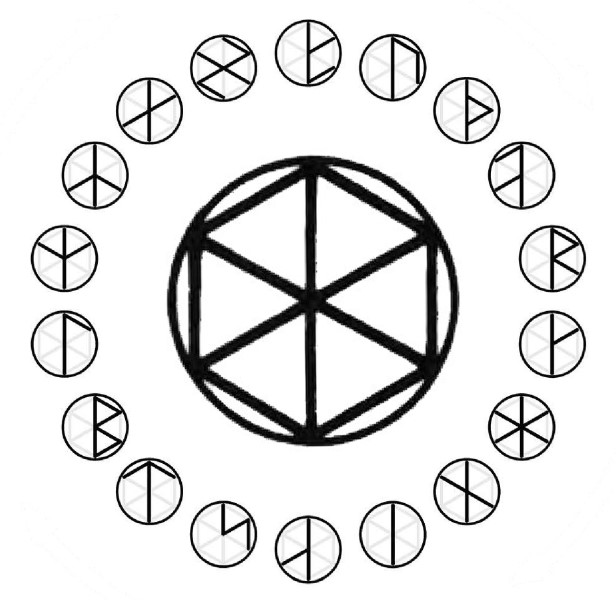A Simple Key to Remembering the ‘Song’ or Mantra(s) associated with the Runes
Need to Summarize and give a table here.
The Runic Hexagon
 _01c.jpg) When Kurtzahn published his rune book in 1924, it had an interesting circular symbol on the cover. It is a circle around a hexagon with lines connecting the corners of the hexagon. This is the earliest appearance of this shape we have been able to find.
When Kurtzahn published his rune book in 1924, it had an interesting circular symbol on the cover. It is a circle around a hexagon with lines connecting the corners of the hexagon. This is the earliest appearance of this shape we have been able to find.
 This shape, called the Runic-Script-Canon [Runenschriftkanons ] by Kurtzahn, but known by various other names (such as the Runic-Circle [Runen-Kreis ], the Hag-All , as well as the Hagal-Hexagon [Hagal-Sechseck ]) contains the “Armanen” Runes and was adopted by many others including Gorsleben and Kummer.
This shape, called the Runic-Script-Canon [Runenschriftkanons ] by Kurtzahn, but known by various other names (such as the Runic-Circle [Runen-Kreis ], the Hag-All , as well as the Hagal-Hexagon [Hagal-Sechseck ]) contains the “Armanen” Runes and was adopted by many others including Gorsleben and Kummer.
As Kurtzahn explains it, the “Side- and Diagonal-Parts form the eighteen Runes”. Meaning that you can make various rune characters out of this shape:

In 1932, Kummer publishes his “Holy Runic-Power” book with a slightly modified version of this Hexagon, converting it into a Six-Pointed Star (fig 1). Then, he extends the lines from the original Hexagon (fig 2), which he calls a Hexagram and an “Initiate-Sigil [Eingeweihten-Sigil ]”. Finally, he connects the extended lines together, making a larger Hexagon, and puts it all back inside a circle (fig 3). This final figure, Kummer considers the “Hexagon containing all 18 Runes”:

Regarding the “Initiate-Sigil”, Kummer says (in his section on the Hagal Rune):
“…as can be seen in Fig. 2 from the above Drawing, the true high Seal-of-the-Priests [Priestersiegel ] contains three Man-Initiation-Runes , thus providing the conclusive Proof of the Authenticity and Sovereignty of this true Initiate-Seal and Hexagram.
The first to make this ingenious Discovery was Mr. Friedrich B. Marby. I consider it of great Importance in Penetrating the high Mysteries.”
Between the early 1900s and the mid 1930s, as Völkisch enthusiasm mixes with runic studies more and more, we see authors building off each other and especially off of Guido von List’s ideas. List’s concept of the pre-Christian “Germanic” Religion having a Priesthood (the “Armanen”) is taken for granted by later authors, who seem to enrich the details of his ideas.
Often, when studying Guido von List, we encounter the term “Ariosophic” or “Ariosophy” (meaning ‘Wisdom concerning the Aryans’). However, this term was not used by List, but was popularized by other Völkisch authors and is often used to refer to certain types of Völkisch studies. List referred to Wuotanism [Wuotanstum ] or Armanism [Armanenschaft ] when referring to the spiritual system he described (which he said was the Germanic or ‘Aryan’ religion in ancient times).
